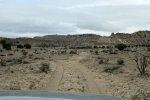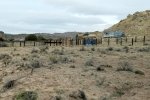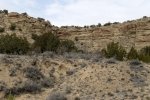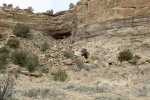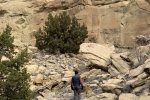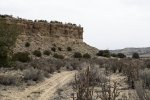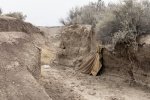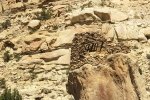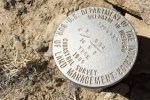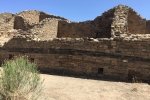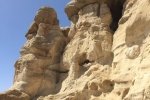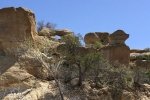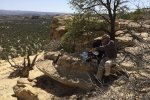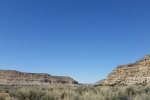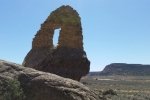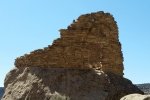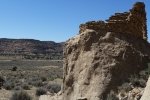It’s been many months since we have been able to get out and about – we needed to begin a recovery from “cabin fever”. Friday evening, with a weekend of nice weather in the offing, spontaneously (no advance planning) we embarked Saturday on a Driveabout, choosing to explore a part of New Mexico that has long been on our bucket list: Valle Vidal.
The Drive In
From Albuquerque, Valle Vidal is a long drive:
- Via Cimarron –
- By way of I-25 to north of Springer, then west on NM 58 – 215 miles, 3 hours
- Or by way of Santa Fe (I-25), Española (US 94/285), Taos (NM 68), and Eagle Nest (US 64) – 186 miles, 3.5 hours
- Then 7 miles north on US 64, turn west on FR 1950, 43 miles to Valle Vidal on a very well maintained gravel road
- Or via Costilla, 2 miles from the border with Colorado –
- By way Santa Fe (I-25), Española (US 84/285), and Taos (NM 68) to Costilla (NM 522) – 178 miles, 3.2 hours
- Then drive east on FR 1950, ten miles on a paved road followed by for 13 miles on gravel, both not-so-well maintained
- And the drive to the Valle is still many miles from the highway.
We weren’t certain that the road through Valle Vidal, FR 1950, would be open for a DriveThru. Passing through Taos, a decision point, we called the Forest Service district office. We did not get a clear answer, ranging from “it is closed” (leaving us to guess if “it” was the road itself) or if there were only restrictions from leaving the road. We decided to go for it, but stay a night in Cimarron, putting the decision about a DriveThru until the next day.
We obtained a reservation for the night at the St James Hotel, a very good choice. We stayed in the Jesse James room, enjoyed a very nice supper in their dining room/bar, and … we weren’t bothered by ghosts (for which the Hotel has quite a reputation).
The next morning we decided to try the DriveThru, risking 1) not able to get into the National Forest at all, or .. 2) finding a gate closed before exiting the other end of FR 1950 dictating that we return to Cimarron. The conclusion – the road was open .. all the way.
The DriveThru

Notes: the graph at the bottom shows elevation of the track (pink area) and speed (the blue line). Press <back> on your browser to return to the post.
From Cimarron we entered from the East, turning off of US 65 onto FR 1950 about 7 miles north of the town. The route starts out in open plains bounded by hills on both sides – a valley passing through a portion of Ted Turner’s Vermijo Ranch.  At about 21 miles we entered into the National Forest.
At about 21 miles we entered into the National Forest. We find the openness of this scenery to be a favorite – grass across the valley, juniper and piñon trees on the hills. There are many side canyons that drew our curiosity (but one is not allowed to leave the road’s right-of-way).
We find the openness of this scenery to be a favorite – grass across the valley, juniper and piñon trees on the hills. There are many side canyons that drew our curiosity (but one is not allowed to leave the road’s right-of-way).

Elevation increases gradually for some 25 miles as this valley becomes narrower.  And as we drove west, snow capped mountains beyond began to appear, adding greatly to the scenery.
And as we drove west, snow capped mountains beyond began to appear, adding greatly to the scenery. The terrain was becoming more varied – taller hills, narrower canyons interspersed with large open areas, each one drawing an exclamation of Wow – open space. About 30 miles in the road began a serious climb from 8,000 feet to Windy Pass (10,000 feet elevation), with a couple of sections with sharp switchbacks. Along the way we checked out the two campgrounds: McCrystal and Cimarron (both closed until May).
The terrain was becoming more varied – taller hills, narrower canyons interspersed with large open areas, each one drawing an exclamation of Wow – open space. About 30 miles in the road began a serious climb from 8,000 feet to Windy Pass (10,000 feet elevation), with a couple of sections with sharp switchbacks. Along the way we checked out the two campgrounds: McCrystal and Cimarron (both closed until May).
Descending from Windy Pass, we entered into the north end of Valle Vidal. We didn’t have the time (or energy) to explore roads going south into the Valle itself. But looking over our shoulder … we would like to come back; given the distances, to make the most of the visit it would best be done as part of a camping trip.
Continuing the drive west was all downhill, through the narrow canyon of the Rio Costilla. Meandering from one side of the Rio to the other, we passed under some amazing rock formations, tall cliffs 100′ to 200′ above the road. And the rocks were in many colors, patterns, shapes – not a vista but interesting scenery themselves. (This got us thinking of getting a GoPro to better document these Driveabouts, and to share some of the scenery.)
Hindsight
 So the DriveThru is 67 miles. Although the road is good (for a gravel road) it makes for a very long day. Especially true as we were constantly being ‘bombarded’ by new views of the scenery – grass valleys, hills, glimpses of snow-capped mountains, and amazing rock formations (particularly on the way out from Valle Vidal itself). We also came upon a pair of Elk and a .. turkey.
So the DriveThru is 67 miles. Although the road is good (for a gravel road) it makes for a very long day. Especially true as we were constantly being ‘bombarded’ by new views of the scenery – grass valleys, hills, glimpses of snow-capped mountains, and amazing rock formations (particularly on the way out from Valle Vidal itself). We also came upon a pair of Elk and a .. turkey.
After that long day of driving, we opted to stay a second night on the road, booking a night at the Hacienda del Sol in Taos. This is a quite nice BnB with much history, the buildings dating back to 1804. In the 20th century, it was the home of Mabel Dodge Luhan and her husband who entertained many notable guests such as Georgia O’Keefe, Ansel Adams, and others. Our room was most comfortable, and … guests enjoy a quite nice breakfast.
The Forest Service restricts access to much of the Valle during various times of the year, particularly during the rutting season for Elk. There are also limitations on camping outside of the Campgrounds. Be advised to check their web site or call ahead for guidance
| GPS Track Files for Download | |
10 Downloads |
|
|---|---|
0 Downloads |
|
If you haven’t explored these hiking tracks with Google Earth, I urge you to try it. With the virtual 3-dimensional presentation, achieved by panning and tilting the view, you can get a much better idea of the hikes and terrain than you can get from the screenshot above. For some ideas, check out Using Google Earth Track Files.
References and Resources
US Forest Service: Valle Vidal Unit
Sante Fe New Mexican: Valle Vidal: Discovering the wonders of the ‘Valley of Life’
National Geographic: Valle Vidal Unit – Carson National Forest
St James Hotel & on FaceBook
Hacienda del Sol










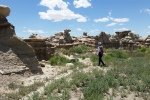
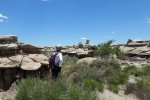
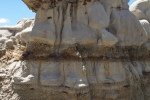
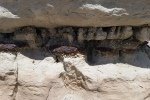
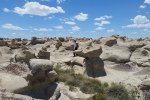
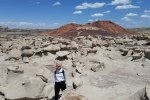


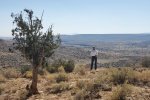
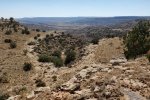
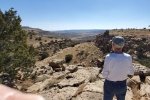
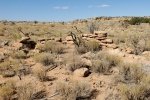
 This was our second hike on a two day adventure in San Miguel del Valle in the Tlacolula Valley in Oaxaca. We spent the night in an Ecotourism cabin in the pueblo, then met our guide Memo for another trip into the Sierra Norte
This was our second hike on a two day adventure in San Miguel del Valle in the Tlacolula Valley in Oaxaca. We spent the night in an Ecotourism cabin in the pueblo, then met our guide Memo for another trip into the Sierra Norte
 The drive took us up a narrow dirt and gravel road that clung to the steep side of the mountains, like yesterday climbing from 5,000 feet to over 10,000. It appeared one section of the road had only recently been carved out, corroborated by the absence of that portion of the road on my topo map and on the current GoogleEarth image. A road like this carved out of the mountain gave us some spectacular views across the large canyon and down towards the open plain of Tlacolula Valley.
The drive took us up a narrow dirt and gravel road that clung to the steep side of the mountains, like yesterday climbing from 5,000 feet to over 10,000. It appeared one section of the road had only recently been carved out, corroborated by the absence of that portion of the road on my topo map and on the current GoogleEarth image. A road like this carved out of the mountain gave us some spectacular views across the large canyon and down towards the open plain of Tlacolula Valley.
 Parking a short distance from the highway, we hit the trail, at first a two-track with easy walking through the high altitude forest of these Sierra Norte mountains. Near the edge of a large relatively flat area, we had a superb view down into a valley leading to San Miguel. A half mile on, we left the forest for an open hillside and views into the valley in the other direction. Turning back to make a loop, we came across developments from past agrigulctural activities, including a circular enclosure of rocks that was used in time past for threshing grains.
Parking a short distance from the highway, we hit the trail, at first a two-track with easy walking through the high altitude forest of these Sierra Norte mountains. Near the edge of a large relatively flat area, we had a superb view down into a valley leading to San Miguel. A half mile on, we left the forest for an open hillside and views into the valley in the other direction. Turning back to make a loop, we came across developments from past agrigulctural activities, including a circular enclosure of rocks that was used in time past for threshing grains.



























